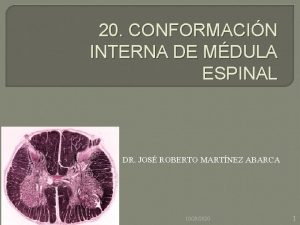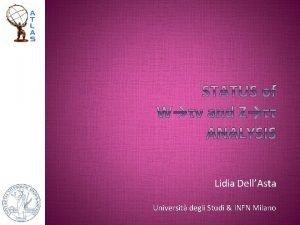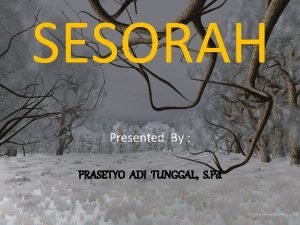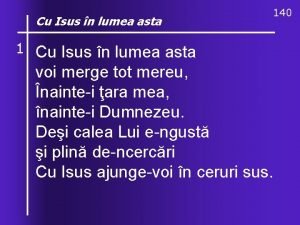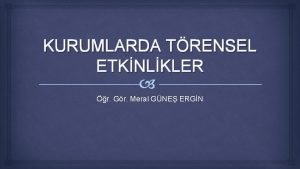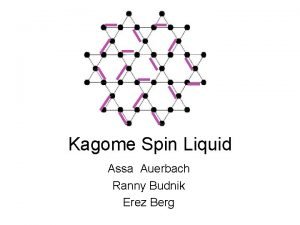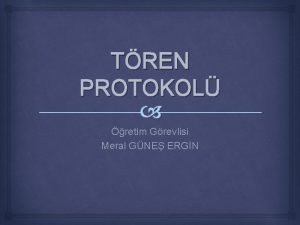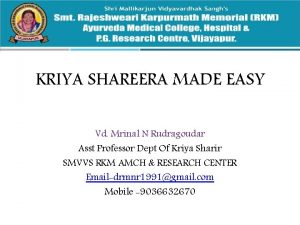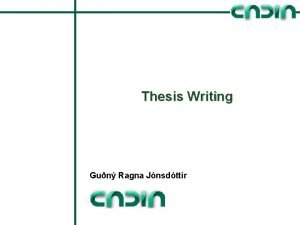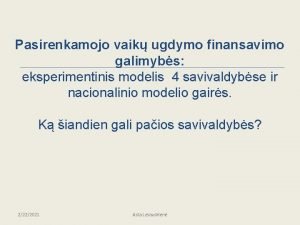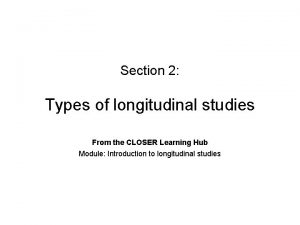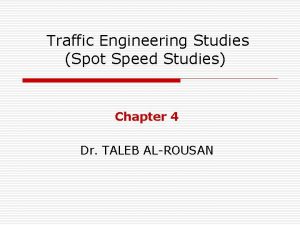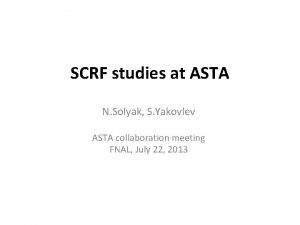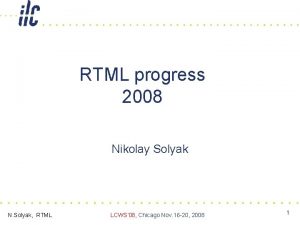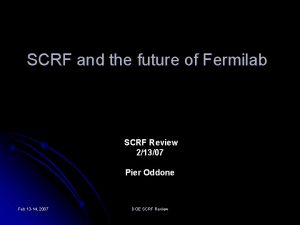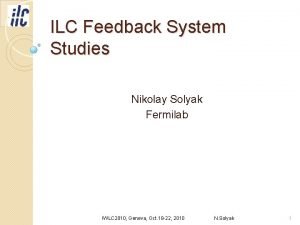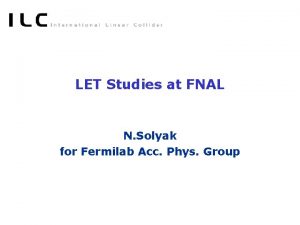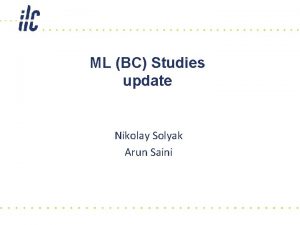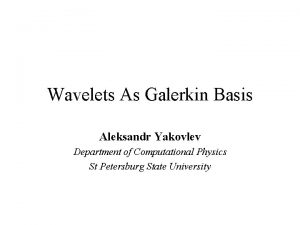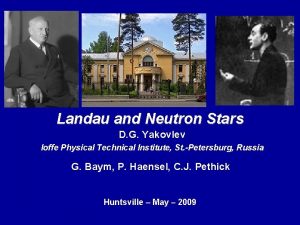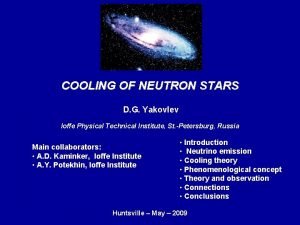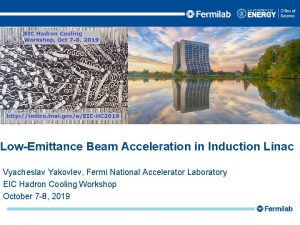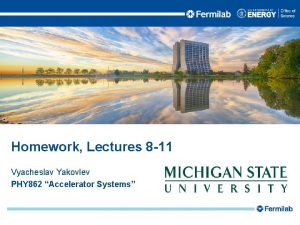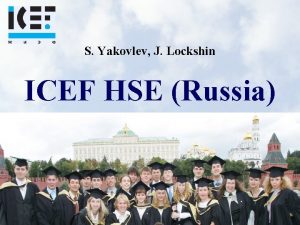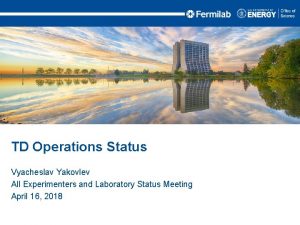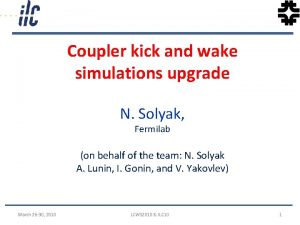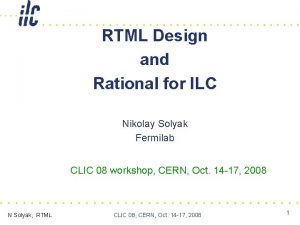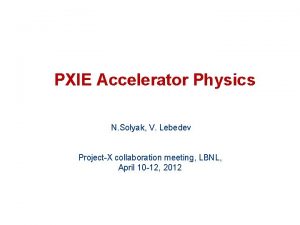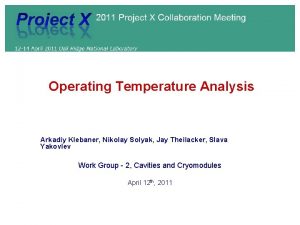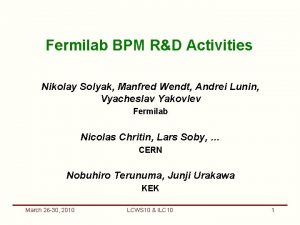SCRF studies at ASTA N Solyak S Yakovlev



































- Slides: 35

SCRF studies at ASTA N. Solyak, S. Yakovlev ASTA collaboration meeting FNAL, July 22, 2013

RF Unit Test Facility • Overall Plan: Test ILC/Pr. X RF units • 3 CM+3 CM, Klystrons, Modulators, LLRF, … • Photo-Injector to provide ILC like beam • New bldg: diagnostic, AARD, cryo plant IOTA, …

NML Facility capabilities • NML will be an unique facility that allows testing SRF accelerator technology for different applications (ILC, Project-X, Muon collider, NGLS, and many other future projects and ideas). • Different projects have different requirements for RF components and systems. Performance of these systems should be tested in the realistic environment. NML facility provides the test bench for such tests with a beam. • These RF systems include. (CW regime may be possible in future also): – Injection systems (gun, laser, capture cavities, bunch compressors, etc); – RF power distribution system (RF sources, power dividers, phase shifters, circulators, input couplers, etc); – RF cavities of different types; couplers – HOM damping systems (HOM dampers and high-frequency HOM absorbers); – LLRF system – Beam diagnostic and correction systems; • NML will allow testing of these systems in different regimes (accelerating gradients, pulse duration, etc…) – tests of the amplitude and phase stability • short/long bunch trains; beam ON/OFF crest

Scope of RF studies • High gradient operation Issues: Operation with spread in cavity gradient Effect of cavity gradient tilt Cavity breakdown Lorentz Force Detuning (LFD) and microphonics compensation – Stable Operation issues – – (ILC/XFEL -1. 5 ms, Pr. X- 8÷ 30 ms, NGLS – CW) • Intense and short bunches operation issues - RF kick, Wakefields, HOM damping, HOM absorbers • Beam diagnostics issues - Using HOM signal for Beam Position Measurement • Testing a new ideas and RF components - Power distribution system

Cavity Gradient Spread FLASH - ACC 67 Gradient spread ~ ± 20% (± 10% ACC 7) • Not all cavities in the ILC/Pr. X will be able to operate at the same gradient. • It is possible to restore flat top operation by tuning each cavity both Q-factor and Input Power (Qi and Pi )*: Index “ 0” corresponds to matched gradient <G 0> for power P 0 Study topics: Gradient, [MV/m] Flattop Operation, Beam ON It works for beam ON, Gradient tilts without beam Time (ms) How well can we flatten the individual cavity gradients How close to quench can we run the cavities with beam How close to saturation can we run the klystron How to ramp up to the maximum current, pulse length, and gradient without quenching • Operational and stability issues • • Good progress from ILC 9 m. A studies (2009 -2012) at FLASH

ILC 9 m. A studies (2009 -2012) at FLASH / DESY Some Key Results • Beam operation with 800 us/4. 5 m. A bunch trains, and… – Gradients of all cavities in vector sum flat within +/-0. 3% (from 15%) – All cavities in vector sum operating within 5 -10% of quench • First experience of ‘high gradient operations management’ – Quench detection / exception handling – Gradient ‘soft limiter’ to dynamically prevent quenching – Data-point of running machine into quench with 800 us/4. 5 m. A • Beam operation with 800 us/4. 5 m. A bunch trains, and. . – RF forward power within ~7% of klystron saturation (typ. 16%) • Ramp-up from ~zero to 800 us/4. 5 m. A pulses without quenching • Rapid recovery (‘crash test’): 800 us/4. 5 m. A -> trip -> 800 us/4. 5 m. A 6

Other Cavity Issues Cavity alignment • Effect of the cavity tilt on beam dynamics. Experimental investigation of a cavity alignment and especially tilt is very important for large – scale accelerators. The cavity tilt provides the beam acceleration in transverse direction and introduces momentum spread along the bunch, which in turn causes the emittance dilution. ASTA allows these measurements. Field emission (FE) and Dark current (spectrum, Energy, etc. . . ) • Filed emission may cause high losses in a CS cavity, and thus, seriously limit the acceleration gradient – SNS is a good example. Thus, investigation of the dark currents, the reasons, the energy spectrum, etc, is essential. ASTA allows experimental investigations of the dark currents, cavity cross-talk due to dark current, that is important for many projects of large SC accelerators. Effect of CM ends to cavity gradient/degradation. • It is noticed (FLASH and SNS experience) that frequently the end cavities in a cryomodule provide less gradient than regular cavities, which limit the gradient of entire section. Sometimes degradation of the gradient in the end cavities takes place. We propose to investigate the reasons of the gradient limitation and degradation in the end cavities at ASTA cryomodules.

Effects of the CM ends (cold to warm transition between cryomodules) Contamination of the end cavities (long term effects) • The end cavities in a cryo-module may be contaminated, which may in turn, cause long – term degradation. Investigation of the source of contamination may help to get rid of this effect. End effect is minimal for ILC/XFEL. Effect of thermal radiation from RT ends to cavities in CM • The end cavities are exposed to thermal radiation from roomtemperature gaps between the cryo-modules, which may lead to additional cryo-losses. ASTA allows all these investigations which may clarify the issues with the end cavities and improve their performance in future SC linacs.

Lorentz Force detuning & microphonics compensation studies for short (~1 ms, ILC) and Long pulses (8 -30 ms, PX) • Range of cavity detuning due to Lorentz forces ~ 1 k. Hz at 25 -30 MV/m, exceed typical cavity pass-band. • It is proposed a detailed investigation of LFD compensation for short pulse, which suitable for ILC operation regime, and for a long pulse, which is essential for high-energy pulse part of the Project X. • This work was already initiated at Fermilab, and impressive results are achieved already. However, further investigations are desired in order to achieve reliable operation of a pulsed linac of the Project X. – New adaptive compensation algorithm was develop and tested (W. Schappert). – Possible feed-back control during long pulse to compensate microphonics

Adaptive LFD compensation in Long pulse operation (9 ms) CM#1 at NML filling time Flat-top W. shappert, Y Pischalnikov, B. Chase, G. Cancello, … N. Solyak, Pulsed Linac Pr. X Col_Meeting, FNAL, Nov. 27 -28, 2012 10

Studies of microphonics Sources of microphonics, spectrum, quantification of contribution from different sources and means to suppress microphonics. • Microphonics (frequency change caused by the cavity wall vibrations) may be cause by different reasons (mechanical resonances, insufficient design of a He vessel and cryo system, etc. ). He pressure fluctuations is a significant contributor. – We propose detailed investigations of the reasons of the microphonics in ILC-type cryomodules, in order to quantify contribution from different sources, determine main reasons of microphonics, and understand the means of the microphonics suppression. – At Fermilab, there works are already initiated, and good results are achieved for SSR 1 cavity. Microphonics due to cavity cross-talking • Another important and poor-investigated issue is microphonics due to cavity cross – talk, i. e. , a cavity vibration influence the frequency of a neighboring cavity and other cavities in same cryo-module. Mechanical coupling of the cavities in a cryo-module may create additional difficulties for microphonics suppression and needs to be investigated Effects of the CM ends to microphonics • Mechanical coupling of a cavity to the environment depends strongly on the cavity position in a cryo-module. The end cavities are in a different position than the regular cavities, which may change microphonics amplitude and possibly create additional problems for their compensation.

ILC cavity HOM studies Studies will be focused on HOM spectrum, trapped modes and effects of HOM excitation to cryogenic losses and beam dynamics. • High Order Modes (HOMs) is an issue for most SC accelerators, major effects are: – additional cryogenic loss in a cavity (monopole HOM’s) – Transverse collective instabilities, beam break-up (BBU) – Beam emittance dilution. • Some of the HOMs may be trapped in multi-cell cavities having, thus, high loaded Q that may lead to the HOM excitation at high amplitude. Careful measurements of the HOM excitation in a ILC-type cavity of ASTA, investigation of resonance HOM excitation and it’s consequences, comparing these measurements to the computer models will provide valuable information for the future superconducting accelerators.

HOM studies (cont. ) Lorentz Force Detuning for the HOM’s • LFD is well investigated for the operating modes in an ILC-type of the cavity. However, there is no any systematic investigation of the Lorentz force detuning for HOMs. These investigations are important for future SC accelerators, especially operating in pulsed regime. HOM frequency detuning due to LFD may help to reduce effects of HOM on the beam. Long term stability of the HOM frequencies for cavity in cryostat • During the operation in a nominal regime, the tuning system maintains the operating frequency. However, Lorentz forces and microphonics may be a reason of long-term changes of the frequencies of HOMs. It was never investigated carefully. It is proposed a detailed investigation of a long-term stability of HOM frequencies for a 1. 3 GHz dressed ILC cavity in a CM.

Lorentz Force Detuning for the HOM’s Range of detuning of the HOM modes due to plastic deformation • Special experiments performed at Horizontal Test Stand (HTS) with the ILC-type 9 -cell cavity, showed that the HOM spectrum changes after detuning of the operating mode and tuning it back (small residual plastic deformations). –This way we can control HOM frequency to escape resonance excitation by beam –In present of frequency stabilization control, HOM spectrum may change from pulse to pulse, decreasing the probability of resonant HOM excitation compared to CW machines. This effect is not investigated yet. SC system of a linear accelerator of ASTA may be used for such investigations, which in turn, are very useful for future long – pulse accelerators. HOM frequency change δf after the operation mode detuning and tuning back by Δf

RF kick and Wakefilds in cavity caused by RF and HOM couples (asymmetry) Downstream HOM coupler Cavity symmetry is broken due to manufacturing errors and, which is more serious, by coupling elements (main power couplers, HOM couplers, etc). These perturbations may cause so-called RF kick and coupler wake, which may lead to significant emittance dilution, especially in a bunching systems, where the bunch is long RF cavity Main coupler Upstream HOM coupler The profiles of the 3 couplers, as seen from the downstream end.

Simulations of Coupler Kick and Wakes On-axis kick factor vs. σz The couplers break the RF field symmetry and cause transverse RF kick and Wakes Total RF KICK 106 · (Vx/Vz) 106 · (Vy/Vz) Q=3. 5 106 -105. 3+69. 8 i -7. 3+11. 1 i Coupler Transverse Wakefield ~20% bunch shape Wx(s)-solid, , Wy(s)-dashed for σz = 300 μm.

ILC: Dilution of the vertical emittance caused by coupler kick and wakes. 450º 360º Can be reduced if phase advance in RF 2 reduce to 360º RF 2 system

Reduction effect of the coupler RF kick & Wake Does not work 1. Symmetrical coupler geometry (upstream coupler rotated 104º) • Wakes – OK • But RF kick increases DESY, SLAC 2. Compact detachable coupler unit that provides axial symmetry of the RF field and the cavity geometry in the beam channel (DESY, FNAL): Zero current in contact area DESY, FNAL SBIR, Euclid Tech. Lab : Other possible compensation schemes • Cryomodule tilt • using Crab Cavity

Studies of propagating high-frequency HOM’s (wakefields) Cryo-losses Damping of the HOMs in absorber • For short bunches (tens of microns) which is suitable not for ILC only, but for light source accelerator (NGLS, for example), the beam current spectrum is very wide, up to hundreds of GHz. These very high order modes may create additional cryo-losses. In order to prevent it, a special HOM absorbers are to be developed and introduced. • Design of efficient HOM absorbers requires careful investigation of very high order mode excitation in a chain of cavities along the linac, dissipation in the SC cavity walls, their radiation to the beam tunnel and intercepting by the absorbers. ASTA allows all these experiments. XFEL HOM absorber (J. Sekutowicz, DESY).

Measurements of HOM absorption efficiency RF frequency 1300 MHz Accelerating gradient 31. 5 MV/m Average beam current in pulse 9 m. A Bunch charge 3. 2 n. C Bunch length σz=300μm Number of bunches per pulse 2625 Bunch spectrum: fmax ~c/ For 300 m bunch the total losses in CM are about 17 W, including ~ 12 W in high frequency (> 2. 9 GHz) propagating modes, that is to be absorbed in HOM line absorber at the end of CM

Direct measurements of the HOM losses* § Measurements of the power dissipation in HOM absorbers at NML. § The power loss vs. the number of modules will allow to extrapolate the losses distribution between the HOM absorbers and RF cavities for the long system. *O. Nezhevenko, S. Nagaitsev, N. Solyak, and V. Yakovlev, ILC Wakefest 2007

Using HOM signal for measurements of beam position in cavity (HOM based BPM). Measurements of the dipole HOMs excited by the beam may be used for measurements of the cavity off set versus the beam axis. These experiments were performed successfully at DESY, with 1. 3 GHz cavity, and with 3. 9 GHz cavity. It is shown that it is really possible to provide reliable and precise measurements using this technique. Resolution < 10 um. Schematic and electronics set up for cavity position measurement using HOMS at 3. 9 GHz section (P. Zhang, N. Baboi, R. Jones, FLASH/DESY)

Cavity HOM signal – BPM* • 2 HOM couplers/cavity can provide useful diagnostic signals to measure beam orbits on single bunch beams • The most interesting modes are in the first two dipole pass-bands -easy to identify - amplitude depends linearly on the beam offset HOM coupler • Excellent beam position monitors (BPM) for single bunch. The theoretical noise limited resolution is ~ 10 nm/n. C • The hardware required for a HOM based beam measurement system closely resembles the “digital down conversion” systems used in many conventional BPM systems. * M. Ross et. al. , Cavity Alignment using beam induced HOM signals in the TTF Linac.

Resolution of Cavity HOM BPM TTF -3 results (M. Ross et. al, 2005) Beam position X predicted from the TE 111 -6 mode signals of cavity #2 vs that predicted from cavities #1 and #8 (end of the CM). The width of the residual ~4. 5 m (signal from 2 cavities). Associated a single cavity error of ~3 m.

Benefits from Using BPM in every Cavity Dispersion Corrected Emittance Growth, nm Presently we are using BPM in only Quad package along with corrector. What if each cavity can be read out as BPM? CURVED Main Linac (50 seeds) BPM w/ YCOR ny = 5. 5 nm r. m. s ~5 nm BPM in every Cavity All the seeds have < 10 nm emittance ny = 4 nm growth r. m. s BPM index

ASTA - test bench for a new ideas in RF components NML HLRF Alternative design Power Distribution System PX Baseline VTO (Variable Tap-OFF) – manually adjustable power dividers to adjust rf split to cavity pairs (requires pair sorting). Alternate Scheme with folded Magic –T’s and motorized U-bend phase shifters. Remotely adjustable by pairs (requires pair sorting). ILC HLRF PDS: (cost 22 KILCU/cav) : (43% 28% 24%) 26 XFEL – Mega: ~ 7 K$ / cavity Pr. X FY 14 Budget. PDS/Klystron/Modulator Workshop, N. Solyak Contract 2013 for cost/schedule study (ILC-SLAC)

Tests of the novel RF components Fast RF vector modulators. Key component for flexibility in phase & amplitude control Key component for pulsed Pr. X to allow fast Feed. Back control of each individual cavity At a front end portion of linac some cavities will require to use vector modulators for amplitude and phase adjustment during the pulse

Example of new designed components Variable hybrid with full range of tuning (replace VTO) Output 2 Input Output 1 • Limit 12 MW in full tuning range • Shorter version for smaller tuning range • Easy automate tuning (S. Kazakov) Alternative phase shifters

FNAL phase shifter for Vector modulator 36 mm (I. Terechkine, T. Khabiboulline, N. Solyak ): Status: Tested at 2 MW; 1 ms - static magnetic field, RF losses < 0. 2 d. B Optimized design for pulse magnetic field Power source: 100 A x 140 V x 25 s; (2. 7 A/ s) Magnetic field and eddy currents @1 k. Hz

Novel ultra-fast ferroelectric phase shifter (S. Kazakov, S. Shchelkunov, V. Yakovlev, J. L. Hirshfield - Omega-P) (b) Phase shifter response: red & blue – phase shift (maximal value is 67 deg; black – HV, peak is 9. 7 k. V). Time response is ~50 nsec! In first design RF losses were high. Further material & design improvements are necessary (new SBIR proposal).

Sub-micron Cavity BPM Vacum coaxial feedthrow for TM 01 mode output Ceramic vacuum window Coaxial feedthrow for TM 11 mode output M. Wendt et al, FNAL. Features: 1. 3 GHz 1. Ceramic (Al 2 O 3) brazed vacuum windows 2. Common TM 110 and TM 010 cavity 3. Symmetrical signal processing 4. Time resolution: ~300 ns (bunch by bunch) 5. Position resolution: < 1 µm (± 1 mm) 4/24/2008

Thermionic RF gun for Project X beam structure In order to model the operation of the RF system in the regime of Project –X linac, a simple inexpensive thermionic gun is proposed instead of rf photo-injector gun* Gun cathode-grid unit is placed into a DESY-type 1. 5 cell cavity. DESY RF gun layout. The photocathode is to be replaced by thermionic cathode-grid unit. *S. Nagaitsev, et al, EPAC 2008

Thermionic gun design parameters Operating frequency, GHz Current, m. A Peak current, m. A Bunch length (95%), deg Cathode diameter, mm Peak cathode loading, A/cm 2 DC voltage, V RF voltage, V Output energy, Me. V rms energy spread at the gun output, % r. m. s. emittance (norm, rms), μm 1. 3 9 -20 200 30 5 2. 5 -3 800 870 2. 5 7 20 Experiments with thermionic gun: § § High-power RF tests: component tests phase and amplitude stability; SC cavity operation; § LLRF operation; Beam dynamics tests: diagnostics; beam parameter measurements; operating with the long pulse at 20 m. A. Experience with auxiliary component operation (cryogenic, tuners, …

Conclusions NML will be unique facility for testing SRF technology for applications in future accelerators: ILC, Project X, Muon Collider, NGLS, etc. : Testing performances of the SRF Cavity and Coupler. Study schemes for effective use of cavity with available gradient. HOM damping/detuning and HOM absorbers performance Beam Diagnostics: BPM and HOM-cavity BPM Effect of beam line components on beam performance: • Coupler RF kick and wake Testing configurations for Power Distribution System and their components: • Fast RF vector modulator, Phase shifters, Variable power divider, circulator, etc. Thermionic gun to generate bunch structure for Project X Welcome new ideas for SCRF studies at ASTA.

Thank you for your attention 2013 XMAC Meeting, Nikolay Solyak 35
 Nucleos del asta posterior
Nucleos del asta posterior Heli tuovinen
Heli tuovinen Lidia dell'asta
Lidia dell'asta Ningali mirsani
Ningali mirsani Cranberol
Cranberol Cu isus in lumea asta
Cu isus in lumea asta Davetlilere hoşgeldin konuşması örneği
Davetlilere hoşgeldin konuşması örneği Asta auerbach
Asta auerbach Asta auerbach
Asta auerbach Resmi törenlerde ödül törenleri üstten asta doğrudur
Resmi törenlerde ödül törenleri üstten asta doğrudur Frank auerbach
Frank auerbach Asta prakriti
Asta prakriti Un'asta di metallo lunga 1 metro a 5 cm
Un'asta di metallo lunga 1 metro a 5 cm ásta ragna jónsdóttir
ásta ragna jónsdóttir Asta lesauskienė
Asta lesauskienė Cayó o calló rae
Cayó o calló rae Andrew auerbach
Andrew auerbach Asta de la medula espinal
Asta de la medula espinal Paradigm shift from women studies to gender studies
Paradigm shift from women studies to gender studies Who studies
Who studies Ferpa case studies
Ferpa case studies Abo discrepancies
Abo discrepancies Ms studies chapter 1
Ms studies chapter 1 Ms studies chapter 1
Ms studies chapter 1 Re past papers eduqas
Re past papers eduqas Longitudinal prospective study
Longitudinal prospective study Multidisciplinary studies epcc
Multidisciplinary studies epcc Sick leave policy in infosys
Sick leave policy in infosys The flynn effect
The flynn effect Current ratio adalah
Current ratio adalah Kansas ela standards
Kansas ela standards Types of map scales in geography
Types of map scales in geography Media influence on voting behaviour essay
Media influence on voting behaviour essay Spot speed study
Spot speed study Exercise #1 – evaluate case studies answer key
Exercise #1 – evaluate case studies answer key 2020 revised curriculum and assessment plans
2020 revised curriculum and assessment plans
